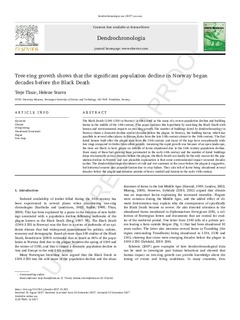| dc.contributor.author | Thun, Terje | |
| dc.contributor.author | Svarva, Helene Løvstrand | |
| dc.date.accessioned | 2018-02-05T11:28:23Z | |
| dc.date.available | 2018-02-05T11:28:23Z | |
| dc.date.created | 2018-01-09T15:29:34Z | |
| dc.date.issued | 2017 | |
| dc.identifier.issn | 1125-7865 | |
| dc.identifier.uri | http://hdl.handle.net/11250/2482593 | |
| dc.description.abstract | The Black Death (1349–1350 in Norway) is often cited as the cause of a severe population decline and building hiatus in the middle of the 14th century. This paper analyses this hypothesis by matching the Black Death with human and environmental impacts on tree-ring growth. The number of buildings dated by dendrochronology in Norway shows a dramatic decline several decades before the plague. In Norway, the building hiatus, which has parallels in several other places in Europe, dates from the late-13th century almost to the 16th century. The first dated houses built after the plague date from the 15th century and many of the logs have exceptionally wide tree rings compared to timber from other periods. Assuming the rapid growth was because of an open landscape, the trees are likely to have grown on infields of farms abandoned due to the 14th century population decline. Since many of these fast-growing trees germinated in the early-14th century and the number of dated buildings drops dramatically several decades before the plague, the Black Death can hardly be the only reason for the population decline in Norway and one plausible explanation is that some environmental impact occurred decades earlier. The dendroclimatological evidence of cold and wet summers in the years before the plague is suggestive, but historical sources also pinpoint famine due to crop failure. They also tell of farms being abandoned several decades before the plague and mention periods of heavy rainfall and famine in the early-14th century. | nb_NO |
| dc.language.iso | eng | nb_NO |
| dc.publisher | Elsevier | nb_NO |
| dc.rights | Attribution-NonCommercial-NoDerivatives 4.0 Internasjonal | * |
| dc.rights.uri | http://creativecommons.org/licenses/by-nc-nd/4.0/deed.no | * |
| dc.title | Tree-ring growth shows that the significant population decline in Norway began before the Black Death | nb_NO |
| dc.type | Journal article | nb_NO |
| dc.type | Peer reviewed | nb_NO |
| dc.description.version | acceptedVersion | nb_NO |
| dc.source.journal | Dendrochronologia | nb_NO |
| dc.identifier.doi | 10.1016/j.dendro.2017.12.002 | |
| dc.identifier.cristin | 1539121 | |
| dc.description.localcode | This is the authors' accepted and refereed manuscript to the article. Locked until 16 December 2019 due to copyright restrictions. | nb_NO |
| cristin.unitcode | 194,31,15,15 | |
| cristin.unitname | Nasjonallaboratoriene for datering | |
| cristin.ispublished | true | |
| cristin.fulltext | postprint | |
| cristin.qualitycode | 1 | |

